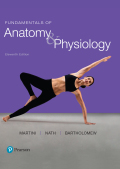
Fundamentals of Anatomy & Physiology (11th Edition)
11th Edition
ISBN: 9780134477336
Author: Martini
Publisher: PEARSON
expand_more
expand_more
format_list_bulleted
Question
Chapter 19, Problem 24RQ
Summary Introduction
To determine:
The methods followed by the elements of blood to defend against the toxins and the pathogens in the body.
Introduction:
Blood is associated with the connective tissue that is present in fluid state. It provides nourishment and oxygen to all the tissues and takes back waste material and carbon dioxide. Blood has many components including red blood corpuscles, white blood corpuscles platelets and plasma.
Expert Solution & Answer
Want to see the full answer?
Check out a sample textbook solution
Students have asked these similar questions
Draw it out, don't just write it. Do the format/diagram.
please draw in what the steps are given.
Thank you!
please draw in and fill out the empty slots from image below.
thank you!
Chapter 19 Solutions
Fundamentals of Anatomy & Physiology (11th Edition)
Ch. 19 - List five major functions of blood.Ch. 19 - Identify the three types of formed elements in...Ch. 19 - Prob. 3CPCh. 19 - What would be the effects of a decrease in the...Ch. 19 - Prob. 5CPCh. 19 - Prob. 6CPCh. 19 - Prob. 7CPCh. 19 - How would liver disease affect the level of...Ch. 19 - Prob. 9CPCh. 19 - Prob. 10CP
Ch. 19 - Prob. 11CPCh. 19 - Prob. 12CPCh. 19 - Prob. 13CPCh. 19 - Prob. 14CPCh. 19 - Prob. 15CPCh. 19 - Prob. 16CPCh. 19 - List the three primary functions of platelets.Ch. 19 - Prob. 18CPCh. 19 - Prob. 19CPCh. 19 - Prob. 20CPCh. 19 - Prob. 1RQCh. 19 - The formed elements of the blood include (a)...Ch. 19 - Prob. 3RQCh. 19 - Prob. 4RQCh. 19 - Prob. 5RQCh. 19 - Prob. 6RQCh. 19 - Prob. 7RQCh. 19 - Stem cells responsible for lymphocytopoiesis are...Ch. 19 - ______ and _______ affect almost every aspect of...Ch. 19 - Prob. 10RQCh. 19 - Prob. 11RQCh. 19 - Prob. 12RQCh. 19 - Prob. 13RQCh. 19 - Prob. 14RQCh. 19 - Prob. 15RQCh. 19 - Prob. 16RQCh. 19 - Prob. 17RQCh. 19 - Prob. 18RQCh. 19 - Prob. 19RQCh. 19 - Prob. 20RQCh. 19 - Prob. 21RQCh. 19 - Prob. 22RQCh. 19 - Prob. 23RQCh. 19 - Prob. 24RQCh. 19 - Prob. 25RQCh. 19 - Relate the structure of hemoglobin to its...Ch. 19 - Prob. 27RQCh. 19 - Prob. 28RQCh. 19 - Prob. 29RQCh. 19 - Prob. 30RQCh. 19 - Prob. 31RQCh. 19 - Prob. 1CCCh. 19 - Prob. 2CC
Knowledge Booster
Learn more about
Need a deep-dive on the concept behind this application? Look no further. Learn more about this topic, biology and related others by exploring similar questions and additional content below.Similar questions
- There is a species of eagle, which lives in a tropical forest in Brazil. The alula pattern of its wings is determined by a single autosomal gene with four alleles that exhibit an unknown hierarchy of dominance. Genetic testing shows that individuals 1-1, 11-4, 11-7, III-1, and III-4 are each homozygous. How many possible genotypes among checkered eagles in the population?arrow_forwardwhat is this called?arrow_forwardcan you help me identify this it's based on onion rootarrow_forward
- Which evidence-based stress management techniques are most effective in reducing chronic stress and supporting college students’ academic success?arrow_forwardstudents in a science class investiged the conditions under which corn seeds would germinate most successfully. BAsed on the results which of these factors appears most important for successful corn seed germination.arrow_forwardI want to write the given physician orders in the kardex formarrow_forward
- Amino Acid Coclow TABle 3' Gly Phe Leu (G) (F) (L) 3- Val (V) Arg (R) Ser (S) Ala (A) Lys (K) CAG G Glu Asp (E) (D) Ser (S) CCCAGUCAGUCAGUCAG 0204 C U A G C Asn (N) G 4 A AGU C GU (5) AC C UGA A G5 C CUGACUGACUGACUGAC Thr (T) Met (M) lle £€ (1) U 4 G Tyr Σε (Y) U Cys (C) C A G Trp (W) 3' U C A Leu בוט His Pro (P) ££ (H) Gin (Q) Arg 흐름 (R) (L) Start Stop 8. Transcription and Translation Practice: (Video 10-1 and 10-2) A. Below is the sense strand of a DNA gene. Using the sense strand, create the antisense DNA strand and label the 5' and 3' ends. B. Use the antisense strand that you create in part A as a template to create the mRNA transcript of the gene and label the 5' and 3' ends. C. Translate the mRNA you produced in part B into the polypeptide sequence making sure to follow all the rules of translation. 5'-AGCATGACTAATAGTTGTTGAGCTGTC-3' (sense strand) 4arrow_forwardWhat is the structure and function of Eukaryotic cells, including their organelles? How are Eukaryotic cells different than Prokaryotic cells, in terms of evolution which form of the cell might have came first? How do Eukaryotic cells become malignant (cancerous)?arrow_forwardWhat are the roles of DNA and proteins inside of the cell? What are the building blocks or molecular components of the DNA and proteins? How are proteins produced within the cell? What connection is there between DNA, proteins, and the cell cycle? What is the relationship between DNA, proteins, and Cancer?arrow_forward
arrow_back_ios
SEE MORE QUESTIONS
arrow_forward_ios
Recommended textbooks for you
 Human Biology (MindTap Course List)BiologyISBN:9781305112100Author:Cecie Starr, Beverly McMillanPublisher:Cengage Learning
Human Biology (MindTap Course List)BiologyISBN:9781305112100Author:Cecie Starr, Beverly McMillanPublisher:Cengage Learning Biology (MindTap Course List)BiologyISBN:9781337392938Author:Eldra Solomon, Charles Martin, Diana W. Martin, Linda R. BergPublisher:Cengage Learning
Biology (MindTap Course List)BiologyISBN:9781337392938Author:Eldra Solomon, Charles Martin, Diana W. Martin, Linda R. BergPublisher:Cengage Learning

Human Biology (MindTap Course List)
Biology
ISBN:9781305112100
Author:Cecie Starr, Beverly McMillan
Publisher:Cengage Learning

Biology (MindTap Course List)
Biology
ISBN:9781337392938
Author:Eldra Solomon, Charles Martin, Diana W. Martin, Linda R. Berg
Publisher:Cengage Learning




Haematology - Red Blood Cell Life Cycle; Author: Armando Hasudungan;https://www.youtube.com/watch?v=cATQFej6oAc;License: Standard youtube license